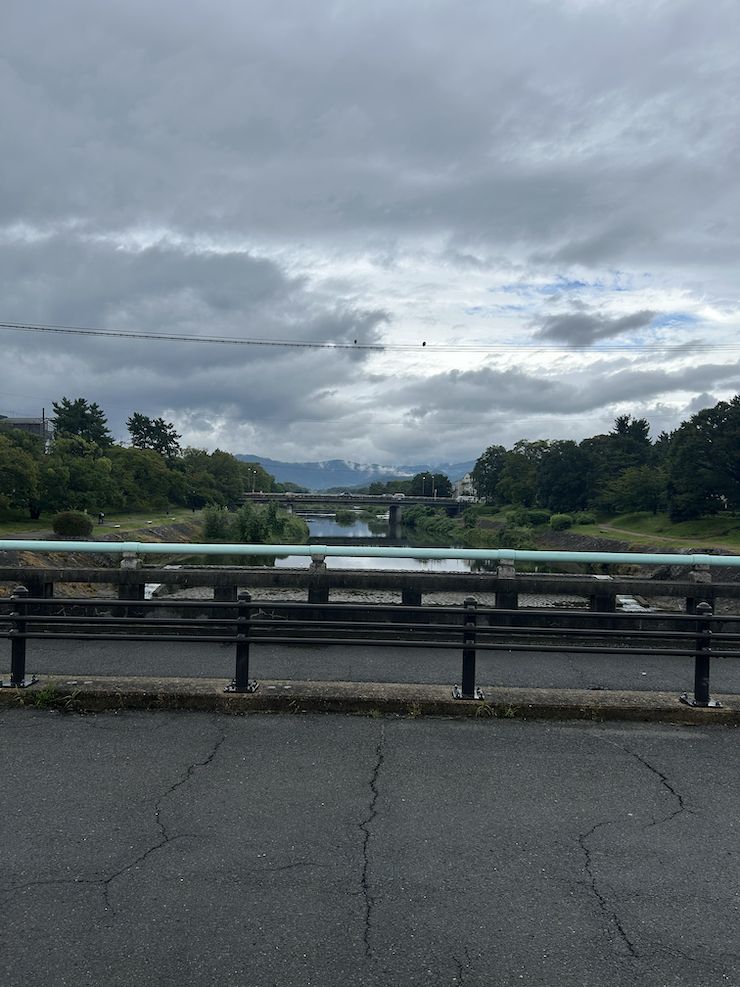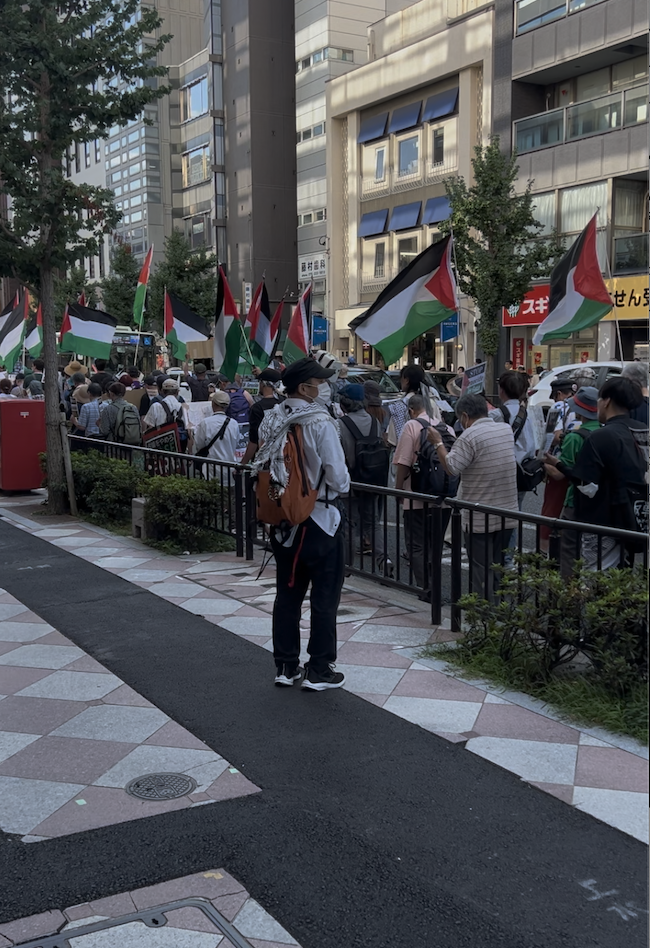I have limited time today to write a blog post and last night I was…
Kyoto Report 2025 – 2
This Tuesday report will provide some insights into life for a westerner (me) who is working for an extended period at Kyoto University in Japan but who over the years of working here has increasingly began to understand the language and local cultural traditions
The beautiful Kamo river
Out running early yesterday, after a stormy night, this is the view north as I crossed the 青龍町 (at Seiryucho).
I actually long for this view when I am away from Kyoto.
The mountains to the North are glorious walking areas and are part of the string of mountains that surround the city.
The paths along the river go for many kms and are great for running without traffic.
Suica app
Catching local trains in Japan is cheap and the service exceptional.
However, for first time travellers, it can be a bit daunting because there are several decisions one has to make when buying a ticket, including sorting through the coins in one’s pocket to find the right ones – if you don’t have an app or a physical IC card.
The Suica IC cards are easily obtained but also easy to mislay and/or lose outright.
The Suica app, which is one of the many IC card systems available in Japan allows for ticketless travel across the entire Japanese rail network, except the Shinkansen services.
It is it issued by the JR East, which is centred on Tokyo, but works across the nation on most lines.
There is no English version though which makes configuring it a little tricky (but doable).
Anyway, this year, with my iPhone, I have a digital version of the physical card (which bypasses the App), which is stored in the Apple Wallet.
Train travel has become that much easier.
Just tap the phone on the IC sensor at the gate, and tap off when finished and it automatically calculates the fare and deducts it from your credit card, also stored in the Apple wallet.
Swimming modesty
This year I have been doing a lot of lap swimming as well as running.
I started with the motivation to participate in a long ocean swim (several kms) next January back in Victoria and while I am an okay swimmer I thought I better train up a bit to do the distance.
So in between running a lot I have been heading to the ocean some days but mostly to the pool to do a lot of laps.
And motivation shifted a little because I have become more interested in technique (as one does) and increasing speed over 2 kms and that has been an end in itself.
My swimming efficiency is greatly improved and I am plotting further gains (as one does).
Anyway, the question then emerged – while I am working over here in Japan for a few months, how can I keep the momentum up?
The answer was to join the local swimming club in my neighbourhood which has a 25m pool available for lap swimmers.
Now that I call myself a lap swimmer in training (-:, one rather looks down on a 25m pool, of course.
At home, the University of Newcastle has a 50m competition pool, which is a really nice place to train.
In regional Victoria, where I spend some of my time (a declining proportion it should be said), I only have a 25m pool available and it feels like I am slumming it.
At any rate, when confronted with scarcity and necessity, one has little choice – so it was off to the swimming club and after a rather onerous process of interview, I am now a full member.
Among the questions I had to sign NO for were:
1. Do you have any tattoos? The swimming club bans people with tattoos.
2. Have you currently or ever had any connections with organised crime? I wondered where swimming clubs were targets.
3. Do you take any illegal substances?
Anyway, NO, NO, NO and a whole lot of other NOs – and I became a member.
Among the conditions, is the requirement to wear a swimming cap.
Problem: I didn’t bring swimmers, goggles, or my swimming cap with me, thinking they are cheap items that any good sport’s store will have here.
Ever the travel packing minimiser!
So it was off to a sport’s store on my bike – which I often do to get odd items – weight bands, running socks, etc.
To my surprise, and this is the cultural note that is the rationale for this little vignette, I couldn’t find any Speedos in the men’s swim wear section.
The section was replete with all the latest equipment – training aids, plenty of goggles, lots of different swimming caps, etc – but no Speedos.
Well there were Speedos but there was also none!
This is one of those situations where capitalism has imposed a specific product on us as a general descriptor of a class of products.
Like Hoovers, Aspro, etc.
So I was looking for Speedos, those famous Australian cossie for me, brief but sufficient.
But the section for men’s swimmers was full of Speedo brand swimmers that were like boxing trunks.
And accompanying them were other products not known in Australia – men’s under-swimmers.
Also in the women’s section there were all these extra modesty devices to cover skin, suppress shape and bumps etc.
Modesty is paramount it seems.
But it also taught me that what constitutes modesty differs across nations.
I consider my swim attire to be quite modest relative to some of the swimmers that are available.
But in this leading sport’s shop in Kyoto, my modest swimmers were unavailable and seemingly a stretch too far.
Palestine activism
I was down near the City Hall in Kyoto, just near the sport’s shop (as above) on Saturday, and there was a Palestinian protest march getting underway with about 100-150 people on the street – this is a very busy and wide street that has a major subway system underneath.
The area from there south to the main station is very crowded, especially on Saturday afternoons.
I was observing the rally and I heard someone call my name. Huh?
Well it was a friend, Professor マツオ タダス (Matsuo Tadasu_, who is a professor in the Department of Economics at Ritsumeikan University and an expert on Marx.
What a surprise.
He is part of the activist movement in Kyoto and explained to me the nature of the Palestinian protest movement in Kyoto.
I joined the march as it proceeded down Kawaramachi-dori (a very busy street), crossed the Shijo intersection, and continued until turning left to finish at 仏光寺公園 (Bukkoji Park), where some speeches were made.
Only a distance of 1.3 kms but through the busiest shopping streets of Kyoto.
It was a really nice group – very noisy – both vocally and with drums, saucepans and other instruments of noise.
At the end, we ate some rice cakes and talked about things.
A solidarity experience that occurs every Saturday at 15:00 from City Hall.
Next week, the marchers will then go on to 円山公園 (Maruyama Park) for some speeches and music presentations after the march is done.
The problem here is the Japanese government is so cowed by the US bullying that they will find it difficult to recognise a Palestinian state, as many other nations have done in recent weeks.
But the activists here are also heavily promoting the – BDS movement – of which I have been a long supporter.
A lot of information as to boycott targets were handed out to those on the footpaths as the march proceeded encouraging them to take moral decisions as part of their consumer behaviour.
I have long believed that consumers have significant power to destroy corporations that do the bidding of those involved in such things as genocide, environmental destruction and more.
That is enough for today!
(c) Copyright 2025 William Mitchell. All Rights Reserved.



“I have long believed that consumers have significant power to destroy corporations that do the bidding of those involved in such things as genocide, environmental destruction and more.”
It’s very reassuring that the plight of the Palestinians in the face of genocide has global support – including in Japan.
We’ve been boycotting all things Israeli since the end of 2023, but we just don’t know what level of solidarity we might have with other like minded people, and that knowledge and sense of unity in the face of injustice would be motivating.
I wonder if activism needs to be redefined and more ‘boycott and harass’ campaigns inspired and organised to shift the elite – especially through economic actions. With social media enabling more ‘people power’ against oligarchic interests, a good organiser ought to be able to marshal support for consumer influence.
Media reporting is often heavily circumscribed by political bias within national broadcasters and dominantly right wing media ownership, so activists need to be able to use media platforms to counteract that.
There is always the concern that bad actors and the ‘tyranny of the majority’ might confuse consumer authority, as social media has a high toxicity quotient, but that ought not deter consumer activism.
Signing online petitions seems to have little impact but hitting corporations through well organised ‘boycott and harass’ drives is a clear way of exerting popular pressures on the plutocratic elite. Flooding politician’s inboxes is another underperforming means of protest given the infrequency of electoral cycles. But hitting them in their pockets …..
I don’t quite know what model major consumer protest might take, but we can act individually yet exert considerable collective pressure at the same time. I’m not sure how some corporate giants like the defence and fossil fuel leviathans might be contained, but they will have chinks in their armour.
A recent example is the immediate, almost accidental, anti-Disney campaign which was so strong that it over-rode their corporate obeisance to Trump’s bullying regime in sacking Kimmel for his critical comments on the MAGA response to the Kirk shooting.
Disney was hit very hard, very rapidly, with estimated $5bn losses in a stock fall of 3.5-4%, yet reversing their decision still came as a surprise. They were hit in their corporate pockets, as well as reputationally, but I think it was the corporate Pavlovian response to potential further financial losses that led their rapid re-evaluation. So it can be done.
Consumer activism is somewhat different from direct political demonstration, and Erica Chenoweth’s 3.5 % rule of thumb outlined for active involvement, (which then encourages higher levels of passive backing), is useful but doesn’t always work. Direct impact on corporate power and especially finances may well involve a different rule for participatory success.
But more consumer activism would be very welcome indeed for us disempowered neoserfs.
I could never work out why a travelcard called ‘Suica’ (スイカ meaning ‘watermelon’ in Japanese) was illustrated with a penguin?
Perhaps Bill could shed some light on this branding mystery?
Best, Mr S
Dear Mr Shigemtisu
Thanks for the observation about the penguin on the Suica card.
It is a good example of why the Japanese language is somewhat hard for an outsider, given that literal readings of the kana or kanji can lead one astray.
Yes, スイカ means watermelons, literally.
But Suica, which looks like a word is in fact an acronym and if we spelt it SUICA that would be clearer. It stands for ‘Super Urban Intelligent CArd’.
They are also known as the Suisui ikeru IC card and this uses the ideophone – ‘sui sui’ – which means:
An ideophone is a word that promotes a sensory experience, such as a sound, movement, color, or shape.
‘Sui sui’ promotes the idea that the card allows you to smoothly and quickly move through the public transport system.
Tap on, tap off – that’s it.
They then commissioned an artist Chiharu Sakazaki to come up with a concept for the launch of the card in 2001.
The Japanese love cute mascots and she came up with the penguin as the symbol of the Suica card because the penguin also moves smoothly and swiftly through the water and is super cute.
That solves your riddle I hope.
best wishes
bill
For the swim club they don’t want any connection with the Yakuza hence the questions about tattoos and organised crime.
Aha, mystery solved! Thank you Bill for your very clear and detailed explanation!
We have the Oyster card in London, (as in “the world is your…”), and no bi-valve graphics to be seen on them either…
Looking forward to more of your Japanese updates, and enjoying that fascinating country vicariously through them.
Best, MrS